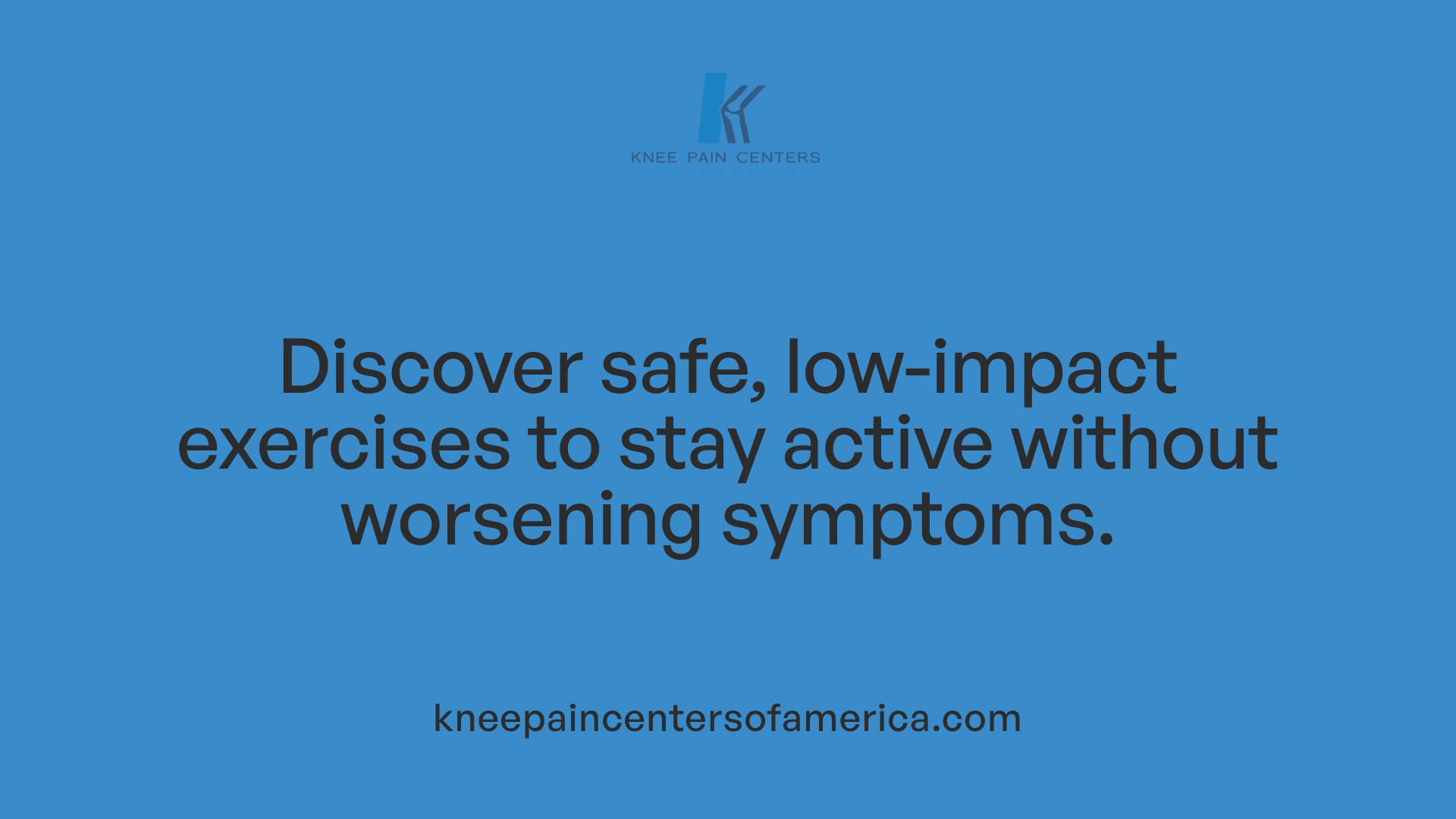Understanding and Managing Flare-Ups of Osteoarthritis
Osteoarthritis flare-ups are episodes marked by a sudden worsening of symptoms such as pain, swelling, and stiffness. These episodes can significantly impact daily life, but with proper management and lifestyle adjustments, their severity and frequency can be minimized. This article explores the causes, symptoms, triggers, and effective strategies to handle flare-ups, empowering individuals to maintain joint health and mobility.
Recognizing the Symptoms of an Osteoarthritis Flare-Up

What are the symptoms of an osteoarthritis flare-up?
An osteoarthritis flare-up is characterized by a sudden worsening of joint symptoms. The most common signs include a significant increase in joint pain, often described as aching or throbbing, which can be either localized or more widespread depending on the affected joints.
Swelling and stiffness are also prominent during a flare, making it difficult to move or use the joint normally. You may notice tenderness when applying gentle pressure over the joint, and the area might feel warm or look red due to increased inflammation.
Reduced range of motion is typical, meaning the joint becomes harder to bend or straighten. In some cases, individuals experience a sensation of joint instability or a feeling that the joint isn’t as strong as usual, which can lead to fear of further injury.
Sleep disturbances and irritability are common, as pain and discomfort interfere with restful sleep. These symptoms can last from a few hours to several weeks, depending on various factors like activity levels, weather changes, or recent injury.
Recognizing these signs early helps in managing the flare more effectively and prevents further joint damage or discomfort. Monitoring triggers such as overexertion, stress, or environmental changes can also aid in reducing the frequency and severity of future flare-ups.
Causes and Triggers of Osteoarthritis Flare-Ups

What causes osteoarthritis flare-ups?
Osteoarthritis flare-ups are episodes where symptoms like joint pain, swelling, stiffness, and reduced movement suddenly worsen, often lasting from a few days to several weeks. These episodes can significantly impact daily life and are usually triggered by a variety of factors.
One common cause is joint injury or trauma. When a joint is injured, it can lead to increased inflammation and damage, setting off a flare-up. Overexertion through excessive physical activity or repetitive movements—such as bending, lifting, or high-impact sports—can also irritate affected joints, worsening symptoms.
Weight gain and obesity play a crucial role, as excess weight puts additional strain on weight-bearing joints like the knees and hips. This increased pressure accelerates cartilage breakdown and can trigger flare-ups.
Environmental factors such as cold weather, rain, or rapid changes in barometric pressure are believed to influence joint pain, although the precise mechanisms remain under study. These weather-related changes may cause joints to become more sensitive and inflamed.
Repetitive activities and physically demanding tasks increase stress on joints, leading to episodes of heightened symptoms. Activities involving prolonged bending, squatting, or heavy lifting can precipitate flare-ups.
Psychosocial factors, including stress, poor sleep, and emotional distress, are known to exacerbate pain perception and can independently trigger or intensify flare episodes.
Certain foods may also influence inflammatory responses. Diets high in processed foods, saturated fats, or sugar can promote systemic inflammation, potentially leading to more frequent or severe flares.
Infections and overall health conditions can contribute as well, especially if they cause systemic inflammation or immune responses that affect joints.
Managing these triggers involves a combination of activity moderation, weight management, injury prevention, and stress reduction strategies. Medications like NSAIDs can help control symptoms during a flare, and avoiding known environmental triggers may reduce the frequency of episodes. Addressing overall health, including diet and sleep habits, can also play a vital role in minimizing flare-ups.
| Trigger Type |
Specific Examples |
Impact on Osteoarthritis |
| Physical exertion |
Heavy lifting, squatting, running |
Increases joint stress, risk of flare |
| Injury or trauma |
Falls, hits, joint sprains |
Initiates inflammation, pain exacerbation |
| Weight gain |
Increased BMI, obesity |
Adds pressure to joints, accelerates cartilage wear |
| Environmental factors |
Cold weather, rain, barometric drops |
Heightens joint sensitivity |
| Repetitive movements |
Repetitive bending, household chores |
Causes joint microtrauma |
| Stress and poor sleep |
Emotional stress, insomnia |
Amplifies pain perception and inflammation |
| Dietary triggers |
Excess sugar, saturated fats |
Promotes systemic inflammation |
| Infections |
Respiratory illnesses, skin infections |
May worsen joint inflammation |
Understanding and managing these triggers through lifestyle adjustments, proper treatment, and stress management can help reduce the likelihood and severity of osteoarthritis flare-ups.
Duration and Course of Flare-Ups

How long do osteoarthritis flare-ups last?
The length of osteoarthritis flare-ups can differ significantly from person to person. Most episodes tend to last between 3 to 8 days, providing a general timeframe for what many patients can expect.
However, some flare-ups may be shorter, lasting only a few hours, especially if triggered by minor activities or temporary factors. Conversely, other episodes, particularly in advanced cases or when managing persistent underlying issues, can extend to several weeks.
Various factors influence the duration of these flare-ups. Age is a notable element; younger individuals under 30 often experience shorter episodes, while older adults above 60 may face longer periods of symptom exacerbation.
The severity of the existing condition, the presence of triggers such as injury or weather changes, and how well the flare-up is managed can also impact its length.
Effective treatment strategies, including appropriate medication, rest, and lifestyle modifications, generally help in shortening flare duration.
Variation from hours to weeks
While the typical duration falls into a few days, some flare-ups resolve quickly within a day or two with minimal intervention. Others, particularly if complicated by additional health issues or delayed medical attention, can linger for several weeks.
It’s important for individuals to monitor their symptoms and communicate with healthcare providers to tailor management plans that aim to reduce the length and severity of flare-ups.
Influencing factors: age, severity, triggers
Age plays a role in both the onset and recovery from flare-ups, with older adults tending to have longer episodes.
The underlying severity of osteoarthritis—whether mild or advanced—also influences how long symptoms persist. More severe cases often have prolonged flare-ups.
Triggers such as injury, weather changes, or overexertion can cause sudden worsening of symptoms but may also prolong recovery time if not addressed promptly.
Recovery pattern and long-term outlook
Generally, flare-ups are temporary and tend to improve with appropriate care. Many people find that managing triggers and adhering to a treatment plan can reduce frequency and duration over time.
Persistent or very long-lasting flare-ups, however, may signal progression of the disease or complications requiring medical reassessment.
Maintaining a healthy weight, engaging in regular low-impact exercise, and addressing underlying inflammation contribute to better overall outcomes. With proper management, most individuals experience stability and fewer severe episodes, leading to an improved quality of life over the long term.
Strategies to Manage and Alleviate Symptoms During Flare-Ups

What strategies can help manage symptoms during osteoarthritis flare-ups?
Managing symptoms during an osteoarthritis flare-up involves a combination of resting affected joints and avoiding activities that cause over-exertion. While rest is crucial, gentle movements and light exercises should still be maintained to prevent stiffness and preserve joint flexibility.
Applying cold packs to inflamed areas can significantly reduce swelling, inflammation, and pain. For some, heat therapy, such as warm towels or heat packs, helps relax muscles, soothe stiff joints, and improve blood flow.
Over-the-counter medications like NSAIDs (non-steroidal anti-inflammatory drugs) or acetaminophen are commonly used to alleviate pain temporarily. These should be taken according to the instructions and under medical guidance, especially for prolonged use.
Incorporating gentle stretching routines and light exercises can help maintain mobility and reduce stiffness without putting excessive strain on joints. Using supportive devices such as braces, splints, or assistive tools like canes can also help alleviate stress on affected areas.
Managing stress through mindfulness, relaxation techniques, and ensuring good sleep hygiene can reduce overall inflammation and improve pain management.
Monitoring your symptoms closely, noting any changes in pain or swelling, and consulting healthcare providers promptly are vital. If flare-ups persist beyond a few days or worsen, professional assessment and possible treatment adjustments are necessary to manage the condition effectively.
Lifestyle and Dietary Modifications to Prevent Flare-Ups
What lifestyle modifications can help prevent osteoarthritis flare-ups?
Preventing flare-ups involves a combination of healthy habits focused on protecting joint health and reducing inflammation. Maintaining a healthy weight is crucial, as excess weight puts additional pressure on weight-bearing joints like the knees, hips, and spine, increasing the risk of pain and swelling.
Engaging in low-impact exercises such as walking, swimming, or yoga can strengthen the muscles around affected joints, improving support and stability. These activities are gentle on the joints, helping to maintain flexibility and mobility without aggravating symptoms.
Managing stress effectively through meditation, mindfulness, and relaxation techniques can lower inflammation levels in the body. Adequate sleep and good sleep hygiene are essential for overall health and reducing joint pain. Proper rest allows the body to repair and heal, decreasing the likelihood of flare-ups.
Protecting joints from overuse and injury is vital. Using supportive devices like braces, orthotics, or assistive tools can prevent excessive strain during daily activities. Avoiding repetitive or high-impact activities that stress the joints helps prevent deterioration.
A nutritious diet rich in anti-inflammatory foods—such as fruits, vegetables, oily fish like salmon, and omega-3 fatty acids—can reduce systemic inflammation, easing symptoms.
Avoiding foods that trigger inflammation, such as processed foods, sugary snacks, saturated fats, and excessive alcohol, is also recommended.
Regular monitoring of early warning signs, such as increased joint stiffness or mild swelling, allows for timely intervention. Consulting healthcare providers to adjust treatment plans and receive personalized advice plays a key role in preventing flare-ups.
By adopting these lifestyle modifications, individuals can better manage osteoarthritis symptoms, maintain joint function, and minimize the frequency and intensity of flare-ups.
Exercise and Movement During Flare-Ups: Safe Practices

What exercises are safe during osteoarthritis flare-ups?
During osteoarthritis flare-ups, it is important to focus on gentle, low-impact activities that help maintain joint flexibility without causing additional pain or swelling. Suitable exercises include range-of-motion movements, light stretching routines, water-based activities such as swimming or water aerobics, and practical walking on flat, even surfaces.
Activities that involve high-impact or deep knee bending, jumping, or running should be avoided during these episodes, as they can exacerbate symptoms and lead to further joint irritation.
Incorporating heat therapy before exercising, such as a warm towel or hot water bottle, can help loosen stiff joints and relax muscles. After exercise, applying ice packs can reduce inflammation and numb pain.
Adjusting the exercise intensity—like using lighter weights or reducing repetitions—is beneficial in preventing symptom aggravation.
It's crucial to listen carefully to your body. If movement increases pain or discomfort, stop and rest. Consulting with a healthcare provider or physiotherapist can provide personalized advice, helping to develop a safe exercise plan suited to your specific condition during flare-ups.
When to Seek Medical Attention for Flare-Ups
When should I seek medical attention for an osteoarthritis flare-up?
Recognizing when a flare-up requires professional care is essential to managing symptoms effectively and preventing potential complications. You should consider consulting a healthcare provider if your symptoms persist for three days or longer. Repeated flare-ups within a short period, such as a month, also warrant medical evaluation.
Certain signs indicate that immediate medical attention is necessary. These include severe pain that does not improve with over-the-counter medications, significant swelling, redness, warmth, or tenderness in the affected joint. If you experience difficulty moving or using the joint, it may be a sign of worsening inflammation or joint damage.
Another critical warning is the presence of signs of infection or severe inflammation. These may include the joint feeling very hot, looking visibly inflamed, or feeling tender to the touch. In cases where the joint appears deformed, locked in place, or making creaking or cracking sounds, professional assessment is advised.
Additionally, if your symptoms interfere with sleep, daily activities, or work, or if you notice any new symptoms such as sudden worsening pain or systemic signs like fever or malaise, seek medical advice promptly.
Getting early care can help reduce pain, improve joint function, and prevent further damage. Consulting your doctor when these warning signs occur ensures appropriate treatment, including medication adjustments or further diagnostic testing.
Medical Treatments in Managing Flare-Ups and Severe Pain
What treatments are available to control osteoarthritis flare-up symptoms?
Managing severe flare-ups of osteoarthritis involves a combination of medical and supportive approaches. For immediate relief, resting the affected joint and applying cold packs can help reduce inflammation and pain. Warm compresses or heat therapy may also soothe stiff muscles and tissues.
Over-the-counter medications are often the first line of treatment. Acetaminophen (Tylenol) is commonly used for pain relief, while non-steroidal anti-inflammatory drugs (NSAIDs) like ibuprofen or naproxen help decrease inflammation and pain. These medications should be taken as directed, and long-term use should be discussed with a healthcare provider.
Physiotherapy and manual therapy play a vital role in maintaining joint function and reducing symptoms. Physiotherapists can guide specific exercises to strengthen muscles around affected joints and improve flexibility, which can help prevent future flare-ups.
For more severe or persistent symptoms, healthcare providers might recommend corticosteroid injections directly into the joint. These injections can rapidly reduce inflammation and provide relief that lasts for weeks or months.
In cases of advanced osteoarthritis, surgical options such as joint replacement procedures may be considered when other treatments have failed. These surgeries can significantly improve quality of life by restoring joint function.
Complementary therapies, including acupuncture and massage, have been reported to help some individuals manage pain and stress associated with flare-ups, though scientific evidence varies. These should be used alongside traditional treatments and under medical supervision.
Assistive devices like braces, shoe inserts, or mobility aids can stabilize affected joints, reduce pain, and improve mobility during flare-ups.
Regular communication with healthcare providers is essential. They can monitor symptom progression, adjust medications, and recommend additional therapies as needed.
By combining these approaches, individuals with osteoarthritis can better control flare-up symptoms, maintain joint function, and improve overall well-being.
Empowering Yourself to Handle Osteoarthritis Flare-Ups
Managing osteoarthritis flare-ups effectively involves understanding their triggers, recognizing symptoms early, and implementing a comprehensive approach that combines medication, lifestyle modifications, and supportive therapies. Regular communication with healthcare professionals, maintaining a healthy weight, engaging in appropriate physical activity, and managing stress are crucial strategies. By staying informed and proactive, individuals can reduce the frequency and severity of flare-ups, preserve joint function, and improve their quality of life. Remember, prompt medical attention during severe or persistent episodes ensures optimal treatment and helps prevent long-term joint damage. Through concerted efforts and personalized care, overcoming the challenges of osteoarthritis flare-ups is achievable, leading to better joint health and overall well-being.
References